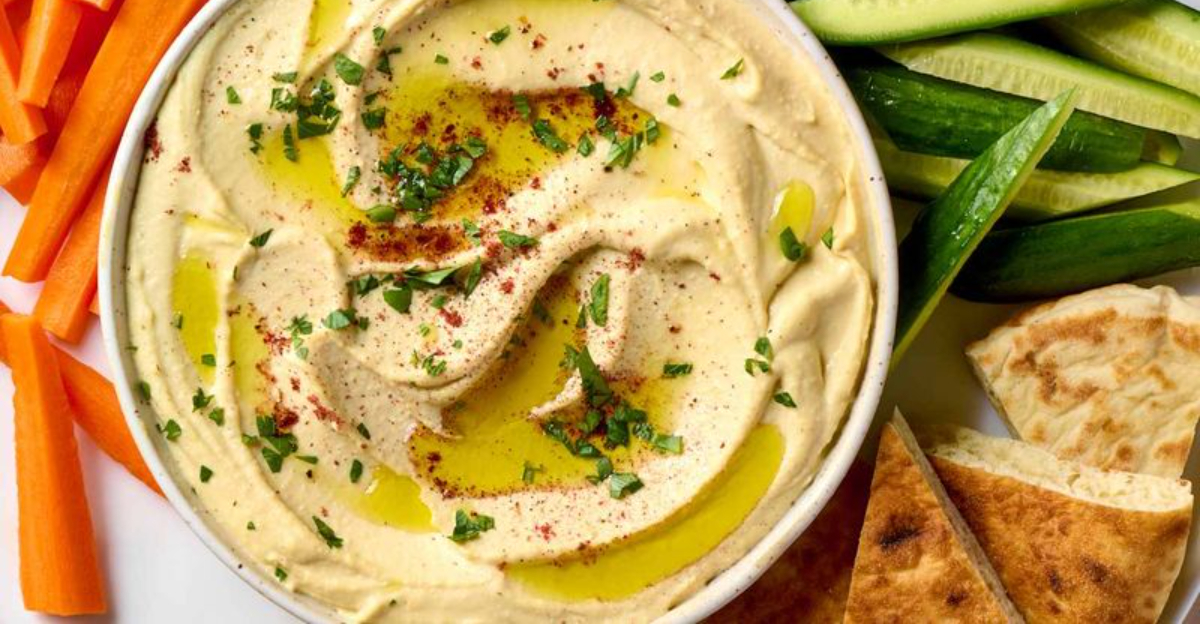10 Mistakes That Are Ruining Your Homemade Hummus

Making hummus at home should be simple, but mine used to turn out grainy and bland until I discovered what I was doing wrong.
The perfect hummus is creamy, rich, and has a balance of flavors that store-bought versions rarely achieve.
If your homemade hummus isn’t quite hitting the mark, you might be making one of these common mistakes that’s standing between you and dip perfection.
1. Leaving The Skins On Your Chickpeas
I once served a batch of hummus that had the texture of cottage cheese because I skipped the de-skinning step. What a disaster! Those papery skins are the nemesis of smooth hummus, creating a grainy texture no amount of blending can fix.
Removing the skins takes a bit of time but transforms your hummus completely. After cooking or draining canned chickpeas, rub them gently between your hands in water – the skins will float to the top for easy removal.
My guests could immediately tell the difference when I started skinning my chickpeas. The extra five minutes of prep resulted in silky-smooth hummus that had everyone asking for my secret.
2. Forgetting The Baking Soda When Cooking Dried Chickpeas
Last month I cooked chickpeas for three hours and they still felt like little pebbles! Baking soda isn’t just some random ingredient grandmothers insist on – it’s chemistry magic for your beans.
Adding about half a teaspoon of baking soda to your cooking water breaks down the pectin in chickpeas, making them softer and more blendable. The alkaline environment created by the baking soda helps chickpeas cook faster and become incredibly tender.
Ever since adopting this trick, my cooking time has been cut nearly in half, and my hummus has that melt-in-your-mouth quality that used to seem impossible at home. Just be careful not to add too much, or your hummus might taste soapy!
3. Neglecting To Add Ice Water While Blending
My food processor was working overtime, yet my hummus remained thick as paste until my Lebanese friend shared her grandmother’s secret: ice water! This seemingly insignificant step completely revolutionized my hummus game.
Cold water creates a reaction with the starches in the chickpeas and tahini, helping develop a lighter, whippier texture. Start by adding just a tablespoon at a time while the food processor is running until you reach your desired consistency.
The temperature matters too – room temperature water won’t give you the same magical effect. I keep a cup of ice water next to me specifically for this purpose, and it’s made my hummus incredibly light and fluffy without diluting the flavor.
4. Using Stale Or Rancid Tahini
That bitter, unpleasant aftertaste in my hummus puzzled me for months until I realized my tahini had been sitting in the pantry since my college days! Fresh tahini should taste nutty and slightly sweet, never bitter or soapy.
Quality tahini makes an enormous difference in your final product. Look for tahini made from hulled sesame seeds with minimal separation and a light color. Give it a taste before adding it to your hummus – if it’s bitter, it’s time for a new jar.
I now store my tahini in the refrigerator after opening and use it within three months. The difference is remarkable – my hummus has a clean, rich flavor without that funky undertone that used to make me question my cooking abilities.
5. Skimping On Tahini Quantity
My earliest hummus attempts tasted like glorified chickpea mash because I was afraid of adding “too much” tahini. Boy, was I wrong! Authentic hummus is actually quite tahini-forward – it’s not just a minor ingredient.
Professional hummus makers often use a 1:1 ratio of chickpeas to tahini, which shocked me initially. Start with at least ⅓ cup of tahini per cup of chickpeas, then adjust to your preference. The sesame paste adds that distinctive creaminess and depth that defines great hummus.
After embracing generous tahini portions, my hummus finally had that restaurant-quality richness I’d been chasing. The flavor became more complex and satisfying, with none of the blandness that plagued my earlier attempts.
6. Blending Raw Garlic Directly Into The Mix
Raw garlic once turned my hummus into a fiery concoction that lingered on everyone’s breath for days! The harsh, spicy bite of raw garlic can completely overpower the delicate flavors in hummus, especially after it sits in the refrigerator.
Try roasting your garlic first, which mellows its intensity while adding wonderful depth. Alternatively, blend the garlic with lemon juice and let it sit for a few minutes – the acid tempers the garlic’s harshness.
My personal revelation was adding the garlic at the very end of the blending process instead of at the beginning. This simple change prevented the garlic from becoming too prominent as it had less time to release its compounds throughout the entire mixture.
7. Drizzling Cheap Olive Oil On Top
My penny-pinching ways once led me to top my hummus with the bargain bin olive oil hiding in the back of my pantry. The rancid, bitter flavor immediately ruined what was otherwise decent hummus!
While you can use regular olive oil in the hummus itself, the finishing oil that goes on top should be your best stuff. That final drizzle is what people taste first, so invest in a small bottle of high-quality extra virgin olive oil specifically for finishing dishes.
Look for olive oil labeled “cold-pressed” and with a harvest date (not just an expiration date). The flavor difference is remarkable – grassy, peppery, and fresh rather than flat or bitter. Your hummus deserves this final crowning touch!
8. Rushing The Blending Process
My impatience used to result in hummus with mysterious lumps and a texture that could only be described as “rustic” (and not in a good way). The secret to silky hummus isn’t just in the ingredients – it’s in the blending time.
Professional hummus makers often blend for 4-5 minutes straight, which seems excessive until you try it. The extended blending incorporates air into the mixture and breaks down the chickpeas completely. I set a timer to ensure I don’t cut this crucial step short.
Scrape down the sides of your food processor several times during blending to catch any rebellious chickpea chunks. The transformation is remarkable – what starts as a thick paste gradually becomes lighter, fluffier, and impossibly smooth.
9. Under-Seasoning Or Seasoning Too Early
The blandest hummus I ever made was perfectly executed in every other way – I just forgot that chickpeas are flavor sponges that need generous seasoning! Another time, I added salt at the beginning only to end up with an over-salted disaster.
Always taste your hummus after blending and adjust seasonings gradually. Salt is particularly tricky – it continues to dissolve and distribute throughout the hummus as it sits. I now add about half my estimated salt during blending, then adjust after the hummus has rested for 10 minutes.
Don’t forget acid balance either! Lemon juice brightens the entire dish, but the amount needed varies based on your chickpeas and tahini. My game-changing addition? A pinch of ground cumin and a dash of smoked paprika to add depth without overwhelming.
10. Improper Storage Techniques
My beautiful batch of weekend hummus once turned into a dry, crusty disappointment by Tuesday because I just threw it in a container and hoped for the best. Hummus continues to develop (and potentially dry out) even in the refrigerator.
Store hummus in an airtight container with a thin layer of olive oil on top to create a seal that prevents air exposure. Before serving, gently stir this protective oil layer back into the hummus for added richness.
Room temperature matters too! Refrigerated hummus tastes muted and thick. I always pull my hummus out of the fridge at least 30 minutes before serving to let the flavors wake up and the texture soften. This simple step makes even three-day-old hummus taste freshly made.
